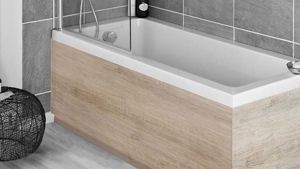Whether you've moved into a new house or you're regretting a past DIY project, painting your tiles is an easy way to give your bathroom or kitchen a refresh. In this guide we'll take you through how you can easily prepare and paint your tiles.
Is Painting Tiles a Good Idea?
Painting tiles is a job which is often hit or miss. You could be left with a lovely finish that will last for many years, or the paint could start to peel after a few days. That's why we only recommend painting tiles as a temporary fix, if you're completely renovating your bathroom or kitchen, we recommend spending some extra money on new tiles.
Tom Drake, bathroom expert at Tap Warehouse suggests that "painting tiles can be a budget friendly alternative to a complete tile renovation, and is a great way to add more character to your bathroom. It's important to be wary of painting tiles in areas which receive high volumes of water, so kitchen and basin splashbacks will be fine, but areas such as showers isn't recommended as your paint will start to peel!"
You Will Need:
- Tile paint
- Grout
- Grout pen
- Sandpaper
- Sponge & toothbrush
- Sugar soap or detergent
- Masking tape
- Paint brush or roller
How To Paint Tiles
Here we'll take you through the steps to paint your tiles. Remember to take your time as any rushing will likely lead to a messy finish!
1. Clean The Grout
Before you start painting it's important to prepare the area first. There are a number of different specialist products and natural solutions available for cleaning your grout. Whichever you choose, spray it across the grout then scrub using a toothbrush. You may need to scrub for a while but the grout should eventually start to look cleaner and fresher.
As you clean the grout, look out for any cracks as you'll want to repair these before you start painting. To repair the grout, you can use a specialist grout crack sealer.

2. Clean The Tiles
Once you've finished working on the grout, you'll want to make sure the tiles are completely clean. Dust, moisture or grease will stop your paint adhering to the tiles properly, so make sure you don't skip this step.
To clean your tiles, mix some sugar soap or detergent with warm water and scrub the tiles with a scourer sponge. If you're painting kitchen tiles, pay extra attention to removing any grease.

3. Sand The Tiles
As tiles are very smooth, you may need to sand them lightly to give the paint something to grip onto. This step isn't always necessary, but it can help you achieve a better finish. If you're unsure, refer to the instructions on your paint tin.
4. Check If You Need To Prime
Depending on the type of paint you choose, you may need to use a primer first. As with sanding you might be able to skip this step but it's always a good idea to check.
5. Tape Around The Tiles
Before you start, grab some masking tape and tape around the area you want to paint. Again, this isn't necessary if you have a steady hand, but it can help prevent any tile paint falling onto the surrounding walls. You might also want to cover your taps and basin to protect them.
6. Paint The Tiles
Once your tiles are clean and everything is protected, you're ready to paint. Tom Drake goes on to say, "the key to achieving a good finish when painting tiles is applying several thin coats. As tiles are very smooth, brush marks will show up if you try to paint too thick. Painting in this way will also reduce the chance of the paint peeling, so it's important to get it right."
You can paint your tiles with a brush or a small foam roller. Make sure you work the paint into the grout to completely cover the tiles and check your paint tin for information on how long you need to leave between each coat.

7. Paint The Grout
If you want the grout to remain a different colour to the tiles, you'll need to use a grout pen once the tile paint has dried. Grout pens apply a thin coating over existing grout to give it a refresh. As you can imagine, this is a job which requires patience and a steady hand but once you've finished, your grout should look like new.
Top Tip: Add a Stencil For a Slick Effect
If you really want to make your tiles stand out, consider using a stencil to create patterned tiles. Whether it's creating a pattern over newly painted tiles or just to hide those tired original tiles, there's a great range of stencils available online. If you're feeling really creative, you could even have a go at making your own.
When painting your tiles, use a foam roller to spread the paint evenly and avoid pushing down too hard as this can cause paint to bleed underneath the stencil, leaving a messy finish.
This is also a great option if you want to go for patterned tiles further down the line, but aren't completely sure you want to commit yet.

That concludes our guide to painting tiles. It's a job that if you have some time and patience, can really improve the look of your bathroom or kitchen. For more help with bathroom & kitchen DIY, take a look at our other how to guides.








